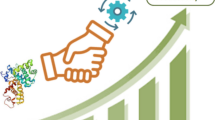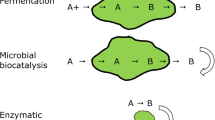Abstract
Chemical reaction engineering is interested in elucidating the reaction kinetics through the determination of the fundamental influencing variables. The understanding of enzyme kinetics is needed to implement the potential of enzymes to satisfy determined production targets and for the design of the reactor. The quantification of the enzyme kinetics is implemented by the elucidation and building of the kinetic model (it includes one or more kinetic equations). In the context of process development, the kinetic model is not only useful to identify feasibility and for optimizing reaction conditions but also, at an early stage of development it is very useful to anticipate implementation bottlenecks, and so guide reactor setup. In this chapter we describe theoretical and practical considerations to illustrate the methodological framework of kinetic analysis. We take as study cases four archetypal kinetic cases by using as example the hydrolysis of cellobiose catalyzed by a beta-glucosidase. We show the different experimental data that can be obtained by the monitoring of enzymatic reactions in different configuration of free enzyme homogeneous ideal reactors; we show step-by-step the visualization, treatment, and analysis of data to elucidate kinetic models and the procedure for the quantification of kinetic constants. Finally, the performance of different reactors is compared in the interplay with the enzyme kinetics. This book chapter aims at being useful for a broad multidisciplinary audience and different levels of academic development.
Access this chapter
Tax calculation will be finalised at checkout
Purchases are for personal use only
Similar content being viewed by others
References
Sheldon RA, Woodley JM (2018) Role of biocatalysis in sustainable chemistry. Chem Rev 118:801–838
Sheldon RA, Brady D (2019) Broadening the scope of biocatalysis in sustainable organic synthesis. ChemSusChem 12:2859–2881
Woodley JM (2020) New frontiers in biocatalysis for sustainable synthesis. Curr Opin Green Sustain Chem 21:22–26
Illanes A (2008) Enzyme biocatalysis. Principles and applications. Springer, Dordrecht
Illanes A, Wilson L, Vera C (2013) Problem solving in enzyme biocatalysis. Willey
Guisan JM, Lopez-Gallego F, Bolivar JM, Rocha-Martin J, Fernandez-Lorente G (2020) The science of enzyme immobilization. Methods Mol Biol 2100:1–26
Sheldon RAA, Brady D, Bode MLL (2020) The Hitchhiker’s guide to biocatalysis: recent advances in the use of enzymes in organic synthesis. Chem Sci 11:2587–2605
Bornscheuer UT (2018) The fourth wave of biocatalysis is approaching. Philos Trans R Soc A Math Phys Eng Sci 376:7
Illanes A, Wilson L, Vera C (2018) Technical biocatalysis. In: Williams G, Hall M (eds) Modern biocatalysis: advances towards synthetic biological systems, vol 32. RSC Catalysis Series, pp 475–515
Buchholz K, Kasche V, Bornscheuer UT (2012) Biocatalysts and enzyme technology. Wiley
Basso A, Serban S (2020) Overview of immobilized enzymes’ applications in pharmaceutical, chemical, and food industry. Methods Mol Biol 2100:27–63
Levenspiel O (1999) Chemical reaction engineering. Ind Eng Chem Res 38(11):4140–4143
Woodley JM (2019) Reaction engineering for the industrial implementation of biocatalysis. Top Catal 62(17–20):1202–1207. https://doi.org/10.1007/s11244-019-01154-5
Illanes A, Cauerhff A, Wilson L, Castro GR (2012) Recent trends in biocatalysis engineering. Bioresour Technol 115:48–57. https://doi.org/10.1016/j.biortech.2011.12.050
Doran PM (2013) Chapter 12—homogeneous reactions. In: Bioprocess engineering principles, 2nd edn. Academic, pp 599–703
Al-Haque N, Santacoloma PA, Neto W, Tufvesson P, Gani R, Woodley JM (2012) A robust methodology for kinetic model parameter estimation for biocatalytic reactions. Biotechnol Prog 28(5):1186–1196. https://doi.org/10.1002/btpr.1588
Dias Gomes M, Woodley JM (2019) Considerations when measuring biocatalyst performance. Molecules 24(19). https://doi.org/10.3390/molecules24193573
Nordblad M, Gomes MD, Meissner MP, Ramesh H, Woodley JM (2018) Scoping biocatalyst performance using reaction trajectory analysis. Org Process Res Dev 22(9):1101–1114. https://doi.org/10.1021/acs.oprd.8b00119
Blackmond DG (2005) Reaction progress kinetic analysis: a powerful methodology for mechanistic studies of complex catalytic reactions. Angew Chem Int Ed Engl 44(28):4302–4320. https://doi.org/10.1002/anie.200462544
Sin G, Woodley JA, Gernaey KV (2009) Application of modeling and simulation tools for the evaluation of biocatalytic processes: a future perspective. Biotechnol Prog 25(6):1529–1538. https://doi.org/10.1002/btpr.276
Dunn IJ, Heinzle E, Ingham J, Prenosil JE (2003) Biological reaction engineering. Wiley
Fernandes RL, Bodla VK, Carlquist M, Heins A-L, Lantz AE, Sin G, Gernaey KV (2013) Applying mechanistic models in bioprocess development. In: Mandenius CF, TitchenerHooker NJ (eds) Measurement, monitoring, modelling and control of bioprocesses, Advances in biochemical engineering-biotechnology, vol 132. Springer, pp 137–166
Halling PJ (2020) Estimation of initial rate from discontinuous progress data. Biocatal Biotransformation 38(5):325–342. https://doi.org/10.1080/10242422.2020.1746771
Duggleby RG (2001) Quantitative analysis of the time courses of enzyme-catalyzed reactions. Methods 24(2):168–174. https://doi.org/10.1006/meth.2001.1177
Zavrel M, Kochanowski K, Spiess AC (2010) Comparison of different approaches and computer programs for progress curve analysis of enzyme kinetics. Eng Life Sci 10(3):191–200. https://doi.org/10.1002/elsc.200900083
Illanes A, Altamirano C, Wilson L (2008) Homogeneous enzyme kinetics. In: Enzyme biocatalysis. Springer, pp 107–153
Illanes A (2013) Enzyme kinetics in a homogeneous system. Problem solving in enzyme biocatalysis, Wiley, In, pp 11–86
Valencia PL, Astudillo-Castro C, Gajardo D, Flores S (2017) Application of the median method to estimate the kinetic constants of the substrate uncompetitive inhibition equation. J Theor Biol 418:122–128. https://doi.org/10.1016/j.jtbi.2017.01.033
Valencia PL, Astudillo-Castro C, Gajardo D, Flores S (2017) Calculation of statistic estimates of kinetic parameters from substrate uncompetitive inhibition equation using the median method. Data Brief 11:567–571. https://doi.org/10.1016/j.dib.2017.03.013
Valencia PL, Sepulveda B, Gajardo D, Astudillo-Castro C (2020) Estimating the product inhibition constant from enzyme kinetic equations using the direct linear plot method in one-stage treatment. Catalysts 10(8). https://doi.org/10.3390/catal10080853
Cornish-Bowden A (1979) Chapter 10—estimation of kinetic constants. In: Cornish-Bowden A (ed) Fundamentals of enzyme kinetics. Butterworth-Heinemann, pp 200–211
Cornish-Bowden A (2001) Detection of errors of interpretation in experiments in enzyme kinetics. Methods 24(2):181–190. https://doi.org/10.1006/meth.2001.1179
Ohs R, Wendlandt J, Spiess AC (2017) How graphical analysis helps interpreting optimal experimental designs for nonlinear enzyme kinetic models. AICHE J 63(11):4870–4880. https://doi.org/10.1002/aic.15814
Pinto MF, Baici A, Pereira PJB, Macedo-Ribeiro S, Pastore A, Rocha F, Martins PM (2020) interferENZY: a web-based tool for enzymatic assay validation and standardized kinetic analysis. J Mol Biol. https://doi.org/10.1016/j.jmb.2020.07.025
Olp MD, Kalous KS, Smith BC (2020) ICEKAT: an interactive online tool for calculating initial rates from continuous enzyme kinetic traces. BMC Bioinformatics 21(1):186. https://doi.org/10.1186/s12859-020-3513-y
Lindeque R, Woodley J (2019) Reactor selection for effective continuous biocatalytic production of pharmaceuticals. Catalysts 9(3). https://doi.org/10.3390/catal9030262
Illanes A, Altamirano C (2008) Enzyme reactors. Springer, pp 205–251
Sharma B, Larroche C, Dussap CG (2020) Comprehensive assessment of 2G bioethanol production. Bioresour Technol 313:123630. https://doi.org/10.1016/j.biortech.2020.123630
Su T, Zhao D, Khodadadi M, Len C (2020) Lignocellulosic biomass for bioethanol: recent advances, technology trends, and barriers to industrial development. Curr Opin Green Sustain Chem 24:56–60. https://doi.org/10.1016/j.cogsc.2020.04.005
Chundawat SPS, Beckham GT, Himmel ME, Dale BE (2011) Deconstruction of lignocellulosic biomass to fuels and chemicals. In: Prausnitz JM (ed) Annual review of chemical and biomolecular engineering, vol 2. Annual Reviews, Palo Alto, pp 121–145
Sorensen A, Lubeck M, Lubeck PS, Ahring BK (2013) Fungal beta-glucosidases: a bottleneck in industrial use of lignocellulosic materials. Biomol Ther 3(3):612–631. https://doi.org/10.3390/biom3030612
Saldarriaga-Hernandez S, Velasco-Ayala C, Leal-Isla Flores P, de Jesus Rostro-Alanis M, Parra-Saldivar R, Iqbal HMN, Carrillo-Nieves D (2020) Biotransformation of lignocellulosic biomass into industrially relevant products with the aid of fungi-derived lignocellulolytic enzymes. Int J Biol Macromol 161:1099–1116. https://doi.org/10.1016/j.ijbiomac.2020.06.047
Wojtusik M, Yepes CM, Villar JC, Cordes A, Arroyo M, Garcia-Ochoa F, Ladero M (2018) Kinetic modeling of cellobiose by a β-glucosidase from Aspergillus fumigatus. Chem Eng Res Des 136:502–512. https://doi.org/10.1016/j.cherd.2018.06.020
Josephson K (1925) Enzymatic fission of glucosides. On the mode of action of beta-glucosidase of emulsin. Hoppe Seylers Z Physiol Chem 147:1–154. https://doi.org/10.1515/bchm2.1925.147.1-6.1
Ionescu CN, Kizyk A (1936) Kinetics of the beta-glucosidase-effect. Ber Dtsch Chem Ges 69:592–597. https://doi.org/10.1002/cber.19360690324
Cornish-Bowden A (2013) Fundamentals of enzyme kinetics. Wiley
Hong J, Ladisch MR, Gong CS, Wankat PC, Tsao GT (1981) Combined product and substrate-inhibition equation for cellobiase. Biotechnol Bioeng 23(12):2779–2788. https://doi.org/10.1002/bit.260231212
Bravo V, Paez MP, Aoulad M, Reyes A, Garcia AI (2001) The influence of pH upon the kinetic parameters of the enzymatic hydrolysis of cellobiose with Novozym 188. Biotechnol Prog 17(1):104–109. https://doi.org/10.1021/bp000142x
Corazza FC, Calsavara LPV, Moraes FF, Zanin GM, Neitzel I (2005) Determination of inhibition in the enzymatic hydrolysis of cellobiose using hybrid neural modeling. Braz J Chem Eng 22(1):19–29. https://doi.org/10.1590/s0104-66322005000100003
Wang GS, Post WM, Mayes MA, Frerichs JT, Sindhu J (2012) Parameter estimation for models of ligninolytic and cellulolytic enzyme kinetics. Soil Biol Biochem 48:28–38. https://doi.org/10.1016/j.soilbio.2012.01.011
Resa P, Buckin V (2011) Ultrasonic analysis of kinetic mechanism of hydrolysis of cellobiose by beta-glucosidase. Anal Biochem 415(1):1–11. https://doi.org/10.1016/j.ab.2011.03.003
Wojtusik M, Vergara P, Villar JC, Garcia-Ochoa F, Ladero M (2019) Thermal and operational deactivation of Aspergillus fumigatus beta-glucosidase in ethanol/water pretreated wheat straw enzymatic hydrolysis. J Biotechnol 292:32–38. https://doi.org/10.1016/j.jbiotec.2019.01.009
Dunn IJ, Heinzle E, Prenosil JE, Snape J (2007) Chemical engineering dynamics: an introduction to modelling and computer simulation. Wiley VCH
Berkeley Madonna (2009) https://berkeley-madonna.myshopify.com/
Acknowledgments
Alvaro Lorente-Arevalo and Alberto Garcia-Martin contributed equally to this work.
Author information
Authors and Affiliations
Corresponding authors
Editor information
Editors and Affiliations
Rights and permissions
Copyright information
© 2022 The Author(s), under exclusive license to Springer Science+Business Media, LLC, part of Springer Nature
About this protocol
Cite this protocol
Lorente-Arevalo, A., Garcia-Martin, A., Ladero, M., Bolivar, J.M. (2022). Chemical Reaction Engineering to Understand Applied Kinetics in Free Enzyme Homogeneous Reactors. In: Magnani, F., Marabelli, C., Paradisi, F. (eds) Enzyme Engineering. Methods in Molecular Biology, vol 2397. Humana, New York, NY. https://doi.org/10.1007/978-1-0716-1826-4_15
Download citation
DOI: https://doi.org/10.1007/978-1-0716-1826-4_15
Published:
Publisher Name: Humana, New York, NY
Print ISBN: 978-1-0716-1825-7
Online ISBN: 978-1-0716-1826-4
eBook Packages: Springer Protocols




